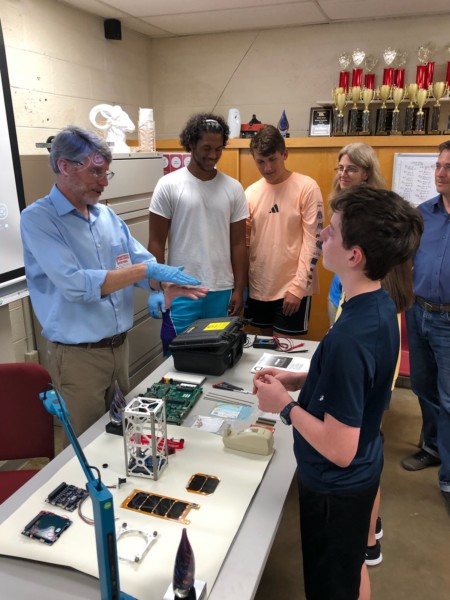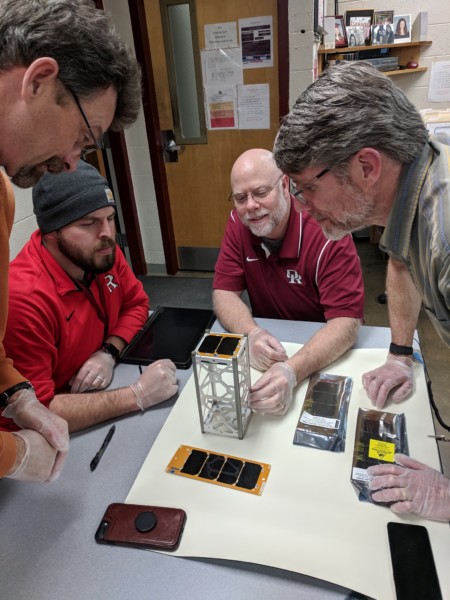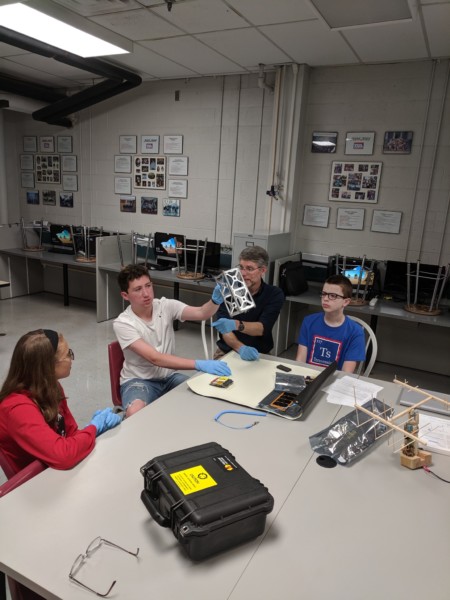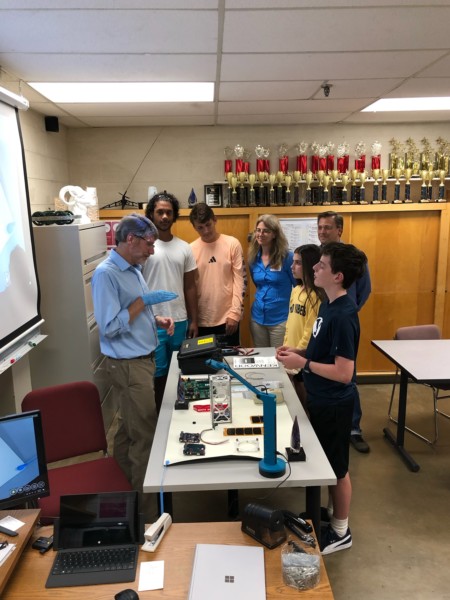
Note: This story was last updated at 1 p.m. Aug. 20.
The small cube satellite built by Robertsville Middle School students with help from teachers, mentors, and NASA is scheduled to launch in October 2020, and it will be deployed from the International Space Station, Oak Ridge Schools announced Monday.
The school system said it has received notification of the launch date from NASA.
“We received the official word from Scott Higginbotham at Kennedy Space Center,” Oak Ridge Schools said in a press release. “His letter stated, ‘RamSat is currently manifested to fly on the ELaNa-31 mission aboard the NG-14 Commercial Resupply Services mission to the ISS. Launch is currently scheduled for October of 2020. NanoRacks will be facilitating the deployment of your spacecraft from the International Space Station.’”
Students have determined the mission of the cube satellite, or CubeSat, will be to circle the Earth and capture images to help them study the regrowth of vegetation in Gatlinburg, as the city recovers from the forest fires of November 2016, the press release said. The satellite has been named RamSat.
Oak Ridge Today reported in March 2018 that RMS was the first middle school to be selected for the NASA program that launches the small cube-shaped satellites into space. At that time, the project, which has received support from corporate donations, was estimated to cost about $70,000.
The Robertsville satellite, which will orbit a few hundred miles above Earth, will use a small camera to try to take pictures of forest regrowth in the Great Smoky Mountains near Gatlinburg. That area burned in forest fires fed by high winds after Thanksgiving 2016, killing 14 people and damaging or destroying more than 2,500 homes and businesses.
RamSat will use a radio to relay its images and other data back to Earth.
A project proposal was submitted to NASA in November 2107, and Oak Ridge Schools learned in March 2018 that the RMS proposal had been accepted.
Once RamSat is in space, major challenges will include correctly orienting the satellite, which won’t have propulsion, and taking pictures of the right spot on the ground as the satellite flies by at somewhere around 17,500 miles per hour in low-Earth orbit.
“It’s very technically challenging to get to that point,” said Peter Thornton, one of the RamSat team leaders from Oak Ridge National Laboratory, in March 2018. “If we get that far, it’ll be a big success.”

The Robertsville satellite could stay in orbit for about a year before plunging back to Earth and presumably burning up in the atmosphere. It will orbit the Earth about every 90 minutes at the altitude of the International Space Station, which ranges from a low of 190 miles to a high of 330 miles. It will be overhead for a maximum of about five minutes at a time. As of March 2018, a network of ham radio operators were expected to help communicate with the satellite, transmitting and receiving data, including pictures.
The goal of RamSat, an educational mission, is to develop and implement a science, technology, engineering, and mathematics curriculum, or STEM curriculum, for middle school students who want to build a cube satellite, or CubeSat.
It’s not groundbreaking science, but it is groundbreaking education, said Thornton, group leader for the terrestrial systems modeling group at ORNL. The seventh- and eight-grade students in “the NASA class” at Robertsville, the enrichment class taught by Todd Livesay, have said they love the experience.
During their time in Livesay’s class, the students have learned important lessons in engineering and computer programming, studied batteries and solar panels, and designed and printed their own plastic CubeSat prototypes using the 3D printers in their class.
The educational curriculum part of the project is led by Holly Cross, supervisor of communications and college, career, and technical education for Oak Ridge Schools, Livesay said Monday.
The press release on Monday provided information about how the project developed. In the fall of 2015, Livesay, a STEM (science, technology, engineering, and mathematics) teacher at RMS, visited Marshall Space Flight Center in Huntsville, Alabama, with NASA scientist Patrick Hull, an Oak Ridge native. Hull introduced Livesay to the 1U (10 cm x 10 cm x 10 cm) cube satellites that his team was designing for NASA and told him some of the challenges they encountered daily. That included figuring out how to create a door that opened remotely in space, as well as how to power the satellites using solar panels.
Livesay then gave the Robertsville Middle School students their first mission in 2015: “We’ve got a challenge for you, Robertsville, we want you to design a 10-centimeter cube satellite and make a door that will remotely open to deploy different objects. There’s your challenge. Go.”
Students took on that challenge, and created designs for such a cube, including a door that opened remotely in space, the press release said.
“They researched diligently and came up with design solutions that exhibited efficient use of materials, included solar panels for power, Arduino boards for programming, and servo motors for deploying the release of the doors,” the press release said. “The research and subsequent explanations delivered by the students was impressive. They presented before several local audiences before finally getting to present their findings to an actual panel of NASA engineers (real rocket scientists!).”
Interestingly, after hearing all of the student presentations, the major takeaway from the panel of experts was that these students needed a scientific mission of their own, the release said. They did not want to settle for the idea that students were simply learning to design a cube satellite with no student-led purpose in mind. The more the panelists spoke, the less satisfied they became with the idea that this project was finished for the Robertsville Middle School students.
As the word spread throughout the NASA organization that middle school students had taken an interest in the NASA Cube Satellite Launch Initiative (CSLI), Livesay got a call from Higginbotham, a NASA scientist at Kennedy Space Center in Florida. He diligently pursued the idea with Livesay that he and a team of local experts from ORNL and Y-12 National Security Complex should pursue the writing of a proposal to create a mission and send an actual cube satellite into space with the CSLI program. This team of experts was created, and while students wrote a mission, the team embarked on a proposal that included two major elements: feasibility and educational merit.
The short name for a cube satellite is CubeSat, and each official CubeSat is given a brand name by the creators of its mission. Robertsville students named their cube satellite, appropriately, RamSat, the press release said. Students thought studying the regrowth of vegetation in Gatlinburg after the forest fires was important because that community provides nearby residents much enjoyment for recreation, including Oak Ridge Schools’ Wednesday afternoon ski clubs, the press release said.

It said students from the NASA RamSat class at Robertsville have taken their ongoing research findings for the equipment and procedures required to put RamSat into space to fulfill its mission back to various panels of NASA engineers at Marshall Space Flight Center for the past two years.
“Each year, the students have grown in knowledge and skills in presentation before expert panels,” the press release said. “The progress has been significant, as witnessed through ongoing recordings of the presentations and progress made toward the date in March of 2018, when we received the announcement that our proposal including feasibility and merit passed the review board. Our proposal to participate in the NASA CSLI was accepted!”
As mentors and students researched the components required to complete their mission, they were encouraged by their technical mentors at Marshall Space Flight Center not to attempt to manufacture any of the final flight components (structure or electronics) themselves, the press release said. But there is still a lot of testing and putting together of pieces before it takes shape as a satellite, the release said.
“The students are getting increasingly engaged in that part of the project, as we acquire and test flight components,” the press release said.
Here is a list of what they have and where they got it:
- 2U frame: Pumpkin Space Inc.
- Flight computer: Pumpkin Space Inc.
- Power control board: Clyde Space Inc.
- Flight battery: Clyde Space Inc.
- Solar panels: Pumpkin Space Inc.
- Attitude determination and control system (magnetorquers): Innovative Solutions in Space
- Flight VHF/UHF radio: Astronautical Development LLC
- Flight VHF/UHF antennas: Innovative Solutions in Space
- Flight cameras (2MPixel Arducam): Arducam
- Ballast: This is a metal piece that the students may actually make themselves. It is essentially a block of machined aluminum to give RamSat extra weight, which will extend the duration of its mission.
- Sun sensor electronics: The solar panels include sensors that indicate the angle of received sunlight. The students will need to fabricate a modest electronics circuit to read the voltages from those sensors.
Everything above is for RamSat itself. The students also have the following components that make up the ground station, for two-way communication with RamSat once it is on orbit:
- VHF/UHF transceiver (amateur radio): Kenwood Inc.
- Roof-mounted antennas: Amsat-NA
Read our previous story here.




More information will be added as it becomes available.
You can contact John Huotari, owner and publisher of Oak Ridge Today, at (865) 951-9692 or john.huotari@oakridgetoday.com.
Most news stories on Oak Ridge Today are free, brought to you by Oak Ridge Today with help from our advertisers, sponsors, and subscribers. This is a free story. Thank you to our advertisers, sponsors, and subscribers. You can see what we cover here.
Do you appreciate this story or our work in general? If so, please consider a monthly subscription to Oak Ridge Today. See our Subscribe page here. Thank you for reading Oak Ridge Today.
Copyright 2019 Oak Ridge Today. All rights reserved. This material may not be published, broadcast, rewritten, or redistributed.
Leave a Reply